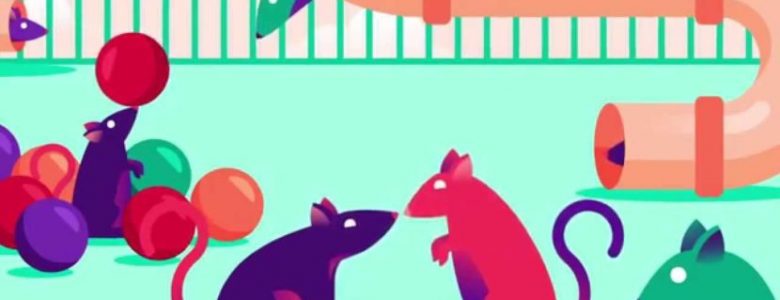
The Rat Park Addiction Experiment
The Rat Park Addiction Experiment proved there’s both an existential and environmental component to addiction. Or didn’t it? Four decades later scientists are still disagreeing about the study’s findings. So we’re here to ask, once and for all: Could Rat Park really be a thing?
The Rat Park Addiction Experiment
Back in the late ’70s, Canadian psychologist Bruce Alexander and some colleagues at British Columbia’s Simon Fraser University conducted a series of drug addiction studies that would come to be known as the Rat Park Addiction Experiment (Rat Park, for short). The studies were based upon a set of experiments where various groups of rats were given a choice between water and morphine. One group was placed in a cage by themselves; another group was set loose in a structure called Rat Park. The first group’s cage was small, very small, and, like we said, they were placed there alone. Rat Park, on the other hand, was 200 times the size of a standard laboratory cage. It also included 16–20 rats of both sexes, food, playthings and enough space for mating.
As you might suspect, Group 1 obsessively went back to the morphine until they eventually overdosed and died. Group 2, however, rarely if ever touched the morphine, instead opting to frolic with their new rat friends and start new rat families. Alexander concluded that it wasn’t so much the drugs that were causing addiction, but the environment. That a happy rat had no need to get high. And, consequently, neither would a happy human.
Reactions to the Rat Park Addiction Experiment
Both Science and Nature rejected Alexander’s Rat Park findings. The former is the peer-reviewed academic journal of the American Association for the Advancement of Science (AAAS) and has been publishing since 1880. The latter is a multidisciplinary scientific journal out of Britain that dates back to 1869. Having these two esteemed journals reject one’s findings must have been a major blow. Then again, the scientific community has a history of being slow to catch up with new science. So maybe, just maybe, the peers at these journals were simply being reactionary fuddy-duddies.
That was Alexander’s take anyway. That’s why he submitted his paper to Pharmacology Biochemistry and Behavior (PBB). Like Science and Nature, PBB is a peer-reviewed scientific journal. Unlike its 19th century predecessors, however, it came of age in the 1970s.
And oh what a difference a century makes. PPB promptly published Alexander’s findings and gave Rat Park some much-needed credibility. It also gave Alexander the respect he sought, as well as a long and storied career. (The clinical psychologist retired in 2005 and continues to serve as Professor Emeritus at Simon Fraser.)
Further studies though showed some mixed results. One found that both caged and “park” rats showed a decreased preference for morphine. That suggested there might be a genetic difference. Another found social isolation can indeed influence drug self-administration levels, but that isolation is not a necessary condition for reinforcing drug use.
Other studies reinforced Alexander’s Rat Park findings. Environmental enrichment did reduce drug-seeking behavior. It also did much to eliminate already established addiction-related behavior. Or, to paraphrase the below video, ‘it wasn’t the chemical; it was the cage.’
Healing Properties’ Take on Rat Park
Healing Properties both applauds and concurs with Alexander’s Rat Park Addiction Experiment findings. Don’t get us wrong. We respect both Science and Nature. But in this case, both esteemed journals were wrong. Way wrong. We’re not saying environment is entirely responsible for addiction. But we are saying it plays a major role. Environment is especially important to addiction recovery.
How do we know? First-hand experience. To begin with, there’s the magic that springs up in Healing Properties’ courtyard. It’s an organic magic. That is, it’s what organically arises when men with similar issues immediately form common bonds. The magic comes when those bonds forge to fight — and then vanquish — a common foe. Here, of course, the foe is addiction. And its defeating is due largely to the camaraderie that develops here at HP.
That camaraderie is by no means limited to our courtyard. Healing Properties institutes a variety of camaraderie-creating endeavors, from our trust-building ropes course and our graduation skydiving adventure, to the weekly recreational outings and thrice-weekly Health & Wellness program.
But perhaps the most evident testament to the deep-rooted camaraderie we create is to be found in our monthly Recovered Alumni Program. This is where scores of Healing Properties success stories come together to provide strong sober support, for themselves as well as the newcomers. They also show the newcomers the benefits to be had from strong sober camaraderie, not to mention sobriety.
But though HP grads may gather around for the monthly Recovered Alumni Program; they don’t stay at the center forever. In fact, the big idea behind our addiction treatment is to equip each man to leave here and go on to lead full — and fulfilling — lives. In other words, to go out and build their own Rat Parks. Because once they’ve got a place where they’ll forever be surrounded by caring friends and loving family and have all the room in the world to live, work and play, they’re much better poised to become sober and productive members of society.
To Sum it Up
Yes, we’ve learned a thing or two since we started treating addiction back in 2002. And one of those things is that the men who went on to live in their own Rat Park had a much better chance at long-term recovery. Was it always easy? Nope. But it was always beneficial. Then again, you don’t need a Rat Park Addiction Experiment to know that putting a person in a nice, safe place and surrounding them with family and friends will be beneficial. That’s just common sense.